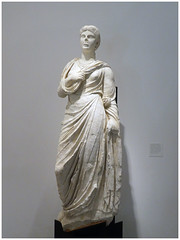The bronze statue of Agrippina Minor on the left is depicted pulling her veil over her head, a gesture of humility and religious devotion. She was the daughter of Germanicus, a war hero, the sister of Caligula, and the mother of Nero.
On the right is the statue of Antonia Minor, mother of the emperor Claudius (AD 41-54), depicted unveiled but with her hands held, palms upwards, in a typical gesture of a religious offerant.
Both statues were discovered in Herculaneum's amphitheater on August 19-20, 1750.
Roman, ca. mid-1st century CE.
Museo Archeologico Nazionale di Napoli, Campania Galleries (Agrippina inv. 5612, Antonia inv. 5599)



















